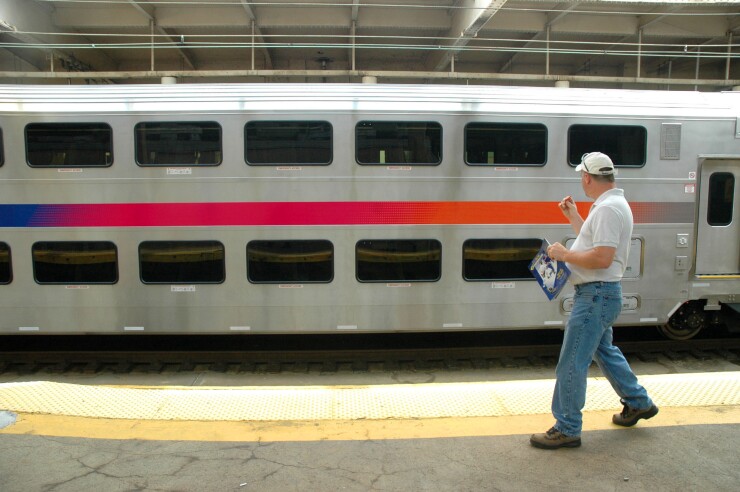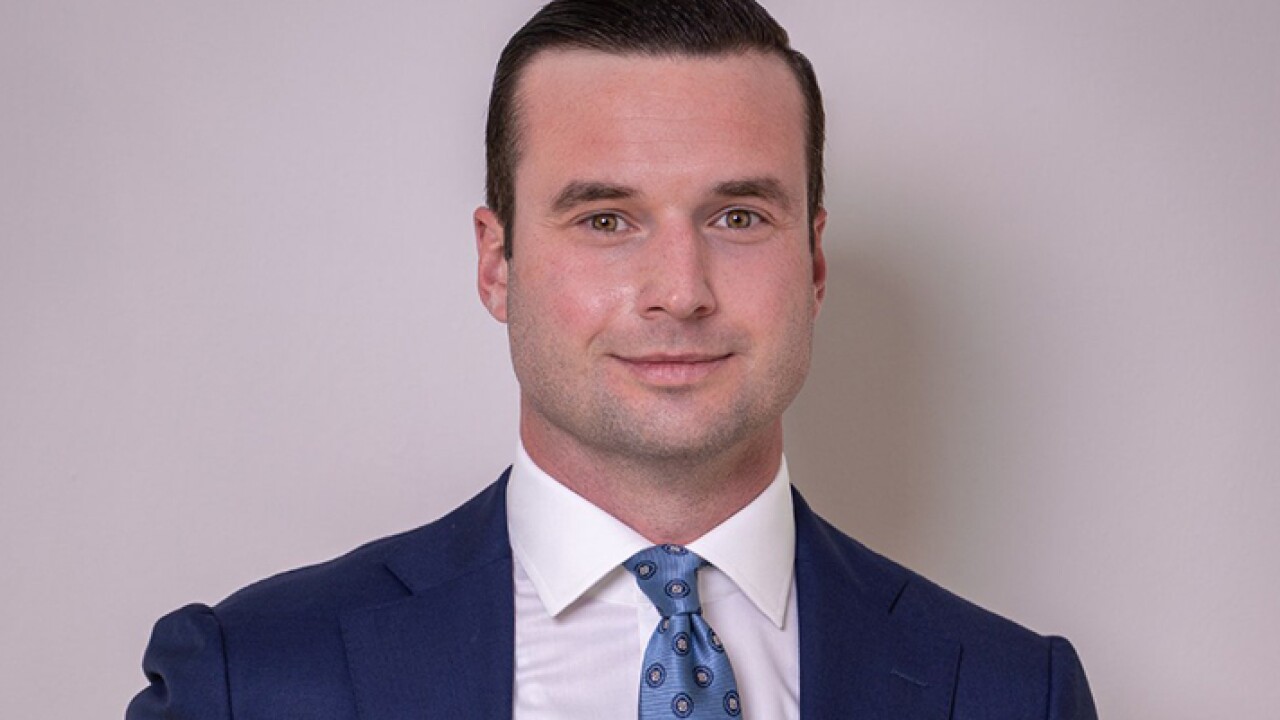U.S. transit systems may not always offer accurate forecasts for when their trains will arrive, but for years, the country's largest transit agencies have made one very solid prediction: they will run out of money in fiscal 2025.
As the agencies spend the last of their federal COVID-19 relief funds, ridership has failed to recover to pre-pandemic levels, and transit systems are traveling ever closer to the fiscal cliff.
With state budgets for fiscal 2025 mostly finalized, systems are weighing rate hikes and service cuts. It's become clear which transit systems have, for now, avoided the fiscal cliff and which are still teetering on the edge. Here's a glimpse at three in the Northeast.

MBTA: Running behind schedule
FY 2019 farebox revenue: $671.5 million
FY 2025 farebox revenue (projected): $400 million
COVID relief funds: exhausted by FY 2026
FY 2026 budget gap: $700 million
New 2025 state funding: Delayed
For many smaller transit systems, those in rural or less dense urban areas, farebox revenue was never a big part of their budgets, according to S&P Global Ratings Associate Director Scott Shad. For those agencies, their major sources of revenue, like state sales taxes, have grown enough in recent years to more than make up the difference from decline fare revenue.
The Massachusetts Bay Transportation Authority is the opposite.
"The MBTA has been in a bit of a fiscal mess for at least the last 20 years, more likely, the last 120 years," said Brian Kane, executive director of the MBTA Advisory Board.
Part of the MBTA's
"In the last 25 years, the T has not really had a balanced budget except maybe once or twice, and at least one of those times is only really on paper," Kane said.
Now, with the hit to farebox revenue from COVID, the MBTA faces a budget gap of
"The service cuts required to close a $696 million deficit in 13 months are simply impossible to propose and still be considered a public transportation provider," the
With a gap this large, state support is necessary, Kane said.
Massachusetts still has not passed its budget for fiscal 2025, but
Budget bills passed by the state House and Senate would give the MBTA $555 million and $361.5 million, respectively. However, even with these proposals, the aforementioned $700 million 2026 budget gap remains.
The MBTA accrued some savings thanks to pandemic relief funds, but its fiscal 2025 operating budget will drain those. The governor created a Transportation Financing Task Force, which will present its findings in December.
Kane, who serves on the task force, said all options for new revenue sources are on the table, except rate hikes.
Healey earlier this year shot down a proposal to put tolls on the New Hampshire border, but the task force is considering other tolls and fees on parking or delivery companies. The MBTA is aiming to spend $93 million less than it budgeted for fiscal 2025, and may find more savings, Kane said. Although Congress has discussed
Transit agencies like MBTA are considered too big to fail. Boston is Massachusetts' economic engine, and the city cannot function if the commonwealth doesn't patch the MBTA's budget, Kane said. He's confident the legislature and governor will find a solution, but not until the last minute.
"We do like to walk up to the edge of that cliff. And let me tell you, we're walking right now here in Massachusetts," Kane said. "All I can hope for is that someone fills in that proverbial gorge before we jump off the cliff."
The MBTA priced
The bonds were rated AAA by Fitch Ratings and Kroll Bond Rating Agency and AA-plus by S&P Global Ratings.
The transit sector has had
NJ Transit: A successful but painful swerve
2019 farebox revenue: $979.9 million
2025 farebox revenue (projected): $947 million
COVID relief funds: exhausted
FY2026 potential budget gap: $917.8 million
New 2025 state funding: $800 million, annually
NJ Transit is the rare system that permanently averted a fiscal cliff. To do so, it raised fares and the state added a surtax on businesses, two contentious decisions that most states and transit systems have been unwilling to make.
Entering 2024, the system's ridership had only returned to
Fees from passengers comprise more than a quarter of
Fare hikes are often unpopular. Higher prices can encourage fare evasion, for one thing. Plus, as speakers at the
NJ Transit CEO Kevin Corbett defended the higher prices in testimony before the state Senate, arguing the alternative to fare hikes was service cuts, which he feared would cause a
Infrequent or unreliable service can dissuade riders, which then brings in even less revenue. Corbett blamed this vicious cycle for the closure of three private bus companies in New Jersey.
"We've seen that firsthand, with the private carriers who lost so much ridership after reducing their service levels. They were unable to recoup that ridership and abandoned their service this past year," Corbett said in his testimony.
NJ Transit recently took over some of those discontinued bus routes, improving reliability and seeing
Even with the revenue from fare hikes, NJ Transit would still have faced a $776.8 million fiscal cliff in fiscal 2026.
Assuming the tax is reauthorized in five years, the state has found its transit agency a new, permanent funding solution.
Minnesota passed a sales tax to fund transit in 2023, and New York has raised taxes, including the payroll mobility tax to support the MTA, Shad said. But other states, including Massachusetts, California, Pennsylvania, and Virginia and Maryland and the District of Columbia, opted for one-time funding instead. Those states may have been motivated by a fear of increasing taxes or a hope that ridership could rebound before they pass their next budgets.
SEPTA: Safe for four more months
FY 2019 farebox revenue: $470.5 million
FY 2025 farebox revenue (projected): $271.8 million
COVID relief funds: exhausted
FY 2026 budget gap: $240 million
New 2025 state funding: $50 million
Pennsylvania came close to a permanent solution to its transit agencies' fiscal cliff.
Instead, the legislature presented the transit agencies with $80.5 million in one-time funding and a promise to try again in September.
The Southeastern Pennsylvania Transportation Authority gets around $50 million of that funding. That's just enough to plug the system's budget gap through October, according to Andrew Busch, SEPTA's director of media relations.
Pennsylvania built a couple yards of bridge before the train plummeted into the ravine.
Pennsylvania's political dynamics mean SEPTA has a harder time securing funding than many similar-sized transit agencies, Busch said. The commonwealth has a history of budget impasses and is currently the only state with a divided legislature, so any issue can trigger a political landmine.
Additionally, fewer than one-third of the commonwealth's residents live in SEPTA's service area, which diminishes SEPTA's political salience.
Crime became a culture war issue; the budget allocated $1.5 million toward a
But transit funding is subject to politics in every state. New York Gov. Kathy Hochul
People who drive and don't live in cities underrate how socially and economically important transit is, said Stephanie Lotshaw, executive director of transit think tank TransitCenter.
"Even if you don't use it, a lack of service availability or a lack of service, period, impacts you," Lotshaw said. "Hospitals, grocery stores, your gym, need people to staff them. All of those folks whose services other people rely on … won't be able to get to their job."
When governments do allocate new funding toward transit, Lotshaw said, pointing to New York's embattled congestion pricing plan, it's often for capital projects rather than the operating budget, where most systems now face impending budget gaps.
Politicians may interpret declining ridership as falling political favor, Shad said. Those politicians would be mistaken, though — when transit funding has been on the ballot, voters support it with margins of 80%, despite falling ridership.
The Pennsylvania legislature will return to Harrisburg in September in the heat of a contentious election season, but Busch said SEPTA is hopeful that lawmakers will recognize the importance of public transit systems.
"We've been working very closely with Gov. Shapiro and the legislature on a funding solution," Busch said. "We're hearing that there is support for getting something done."
No lawmakers have told SEPTA whether the September funding would come from sales tax revenue or another source, Busch said. Earlier in budget negotiations, lawmakers suggested funding
If SEPTA receives the funds it was initially budgeted, it will spend about $76 million of its service stabilization fund over the rest of its five-year operating plan, Busch said.
The agency plans to implement a modest fare hike, commensurate with inflation, in 2026. If its budget gap goes unfilled, SEPTA would have to hike fares by roughly 20% and cut service by roughly 30%.





